The basic principles of animal welfare are:
- Animals must be provided with food and water.
- Animals must be handled properly.
- Animals must have access to health care.
- Animals must have environmentally appropriate housing that is suitable for their species and behaviour.
- Animals must have a lifestyle that is free from stress, pain, and suffering.
There are 5 freedoms of animal welfare that all animals are entitled to. The 5 freedoms of animal welfare are:
- Freedom from hunger and thirst
Ready access to fresh water and a diet to maintain full health and vigour. - Freedom from discomfort
Appropriate environmental settings including shelter and a comfortable area for rest - Freedom from pain, injury and disease
Prevention of pain, injury and disease through proactive diagnosis and treatment - Freedom to express normal behaviours
Providing sufficient space, proper facilities and company of the same species - Freedom from fear and distress
Ensuring conditions and treatment that avoids mental suffering
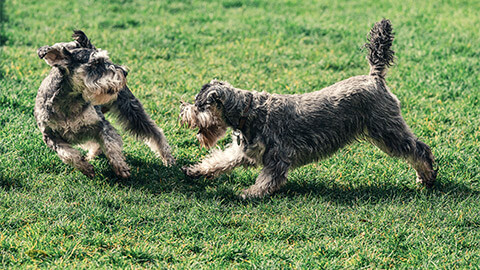
Dogs may have inside or outside lifestyles but must have their basic welfare needs taken into consideration. Any environment must ensure that the dog is safe from predators and also prevent the dog from being a predator themselves.
Housing
Dogs can be housed indoors and outdoors or a combination of both. When housing a dog the most important considerations are as follows.
- Outdoor enclosures are completely escape-proof. Dogs are very capable diggers, chewers, climbers, and jumpers.
- Bedding is made of non-toxic materials. Some dogs will chew and even swallow pieces of damaged bedding.
- Bedding also needs to be warm and dry and completely washable for convenience.
- Raise the bedding off the floor as this will assist with the drainage of urine and increase comfort levels for the dog. It is particularly important that raised bedding is provided for elderly and arthritic patients, to decrease the pressure on painful bones and joints.
- Provide toys that can be chewed. Dogs love to keep their teeth sharp by gnawing on fake bones or other toys.
Temperature and Ventilation
- Depending on the dog's breed, age and condition, dogs should ideally be housed at a temperature between 15 – 25 degrees Celsius. Where possible major temperature fluctuations should be avoided. Good ventilation is essential to housing dogs comfortably inside. An outdoor enclosure must also have protection from the weather, for example, a kennel or covered enclosure of some type in which their bedding is kept.
Exercise and Socialisation
Dogs need regular exercise, some breeds more than others. Exercise can include walks, runs in the park, or chasing a ball. Exercise is an important social aspect for dogs. Dogs can live in groups or solitary. In the wild, they would live in packs, however domestic dogs see their human family as their pack.
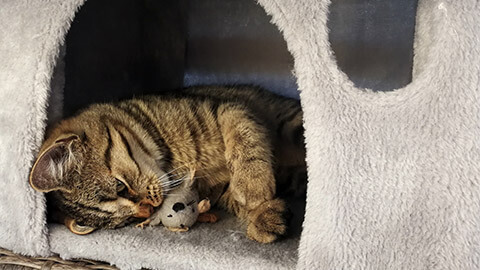
Cats are natural predators and will hunt birds, possums, mice, rats, and other small creatures. When advising clients on suitable living environments perhaps consider inside environments or speciality enclosures. Likewise roaming cats often get into fights or get attacked by other predators which can cause injury and disease.
Housing
Cats can be housed indoors and outdoors or a combination of both. When housing a cat the most important considerations are as follows.
- Indoor cats will require litter trays (one per cat plus one extra in a multi-cat housing situation is recommended).
- Provide a warm place to sleep and retreat.
- Provide scratching posts, climbing areas, and windows if the cat is being housed indoors. Cats love to keep their claws sharp, climb, play and bask in the sun.
- To prevent the cat from becoming a predator, some people provide specially designed outdoor cat runs, known as 'cat parks'. Cat parks are outdoor, escape-proof enclosures and they provide a safe and secure way for cats to enjoy the sunshine and fresh air of the outdoors. The installation of a cat park also eliminates the chances of cats fighting with other cats, car accidents, injuring or killing wildlife, and getting lost or running away.
- If you are housing the cat long term you should also incorporate specific environmental enrichment elements to decrease the chances of boredom resulting in self-destructive behaviours. This may include specific cat toys.
Temperature and Ventilation
- Depending on the cat's breed, age and condition, cats should ideally be housed at a temperature between 15 – 20 degrees celsius Where possible major temperature fluctuations should be avoided. Good ventilation is essential to housing cats comfortably inside.
Exercise and Socialisation
Cats have a natural prey instinct, so love to chase their tails or a toy such as a ball. They love to climb, so the inclusion of a climbing frame is a valuable inclusion to their environment. Some cats will tolerate and even seek out human interaction others are happy to entertain themselves. Cats can live happily with other cats or domestic pets, however, they do take a while to adjust to a new companion. Ensure you gradually introduce other animals to an existing cat, and be prepared for some initial hissing, growling, and even attacking.
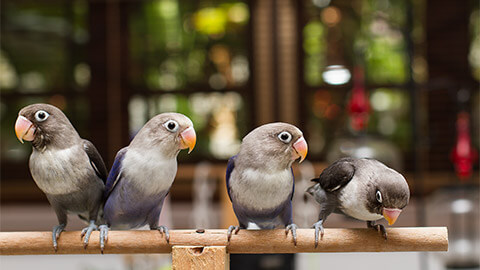
Birds are kept either indoors in cages or outdoors in aviaries. Cages are normally used to house one or two small birds, aviaries are suited to groups and/or larger birds.
Housing
It is important to inspect housing daily for signs of damage, as bent and broken wires can cause serious injury to curious birds.
Factors to consider when setting up a cage.
- Ensure there is adequate shelter, do not place the cage in direct sunlight or in the rain.
- The minimum cage size for a pair of birds should be three times their combined wingspan. Ideally, the birds should be able to fly around freely without hurting themselves.
- Perches should be of varying widths, consider having a natural branch in the cage for variety.
- Do not place water dishes directly underneath perches as they will become contaminated.
- Provide environmental enrichment, for example, bells, ladders, and mirrors. However, be mindful to not overfill the cage.
Factors to consider when setting up an aviary.
- Choose wire strength that reflects the type of birds being housed, large parrots have extremely strong beaks and can bite through the soft wire with ease.
- Vermin proof the aviary. Snakes, cats, mice, and rats love birds and will try to attack them. The aviary should have a concrete base to prevent access.
- Make sure the door is secured, many larger birds may be able to open doors using a combination of their beaks and feet.
- If housing breeding birds, the aviary needs to contain enough nesting sites for all pairs, and adequate nesting material should be provided, peat moss or coconut fibre will suffice.
- Perches should be positioned so that flight space is not reduced, there should also be enough perch room for all birds under shelter.
Temperature and Ventilation
- Do not place cages or aviaries in excessively draughty areas but remember that birds do enjoy some sun and fresh air.
Exercise and Socialisation
- Birds are social creatures and enjoy interacting with other birds. Consider housing in pairs or groups. If the bird must be housed individually then ensure it has plenty of interactive toys and a mirror to provide entertainment.

Reptiles are poikilotherms, meaning they are unable to generate sufficient heat on their own to drive their metabolism. It is, for this reason, that heat management when housing reptiles is essential.
Housing
Enclosures for land-based reptiles (lizards and snakes) are known as vivariums. They are usually made of Perspex or glass with a wire or mesh covering. Turtles are generally kept in glass tanks or aquariums, which allow for easy observation. There should be two sections within the enclosure: a water section and a landing area. Reptiles are usually solitary creatures however some species can be housed in small groups.
Factors to consider when setting up vivariums.
- Ensure it is escape-proof, some lizards are excellent climbers and snakes can squeeze through gaps as small as 4mm. Use a secure latching system and keep doors and/or covers closed.
- Provide a heat lamp and a UV lamp and ensure the temperature is consistent.
- Line the flooring with an appropriate substance (will vary depending on the type of reptile). Do not use wire bottomed enclosures as lizard feet/toes can be damaged or amputated, also do not use gravel as lizards can ingest stones.
- Include a hide. These may be made from artificial material or materials found naturally in their preferred habitats. Hides provide safety and solace to animals digesting food or protecting themselves from perceived danger.
- Ensure the vivarium is large enough for the reptile, lizards like to move around quite a bit and even snakes can be quite active.
- Offer a basking rock.
Factors to consider when setting up aquariums.
- Water should be at least 15cm deep (increased as the turtle grows).
- The temperature of the water should not exceed 28 degrees celsius
- A good filter is essential to ensure optimum water quality.
- Calcium blocks can be used to reduce acidity in the water and assist with maintaining a strong, healthy shell.
- Include a ramp so that the turtle can walk up onto its landing area.
Aquariums must be cleaned regularly to prevent algae and dropping build-ups. Water changes of at least 25% should occur weekly as well as pH tests to ensure levels are between >7 to 8.4. Decorate the aquarium with gravel, wood, rocks, ornaments, and water plants.
Temperature and Lighting
Full-spectrum fluorescent tubes are adequate sources of UVA and UVB for most reptiles. Sun-seeking reptiles such as Bearded Dragons may require a specific UVB light source as well. 'Zoo Med Reptisun' and 'URS Outback Max' are UVB light sources suitable for use with high UVB requiring reptiles. UVB is required to facilitate calcium metabolism and strong bones via Vitamin D activation. Reptiles appear to need to be exposed to higher temperatures to utilise the UVB/Vitamin D interaction in their skin. UVA appears to be necessary for normal behaviour in captive reptiles. Generally, reptiles in captivity should be offered day/night lighting cycles that reflect the seasonal variation. Any form of lighting should be covered in mesh to prevent the reptile from sustaining burn injuries.
Ideal temperatures for various reptiles are as follows.
- Skinks, dragons, and goannas: 30oC – 35 degrees Celsius
- Geckos and legless lizards: 32oC
- Small pythons: 30oC - 33oC
- Larger pythons: 20oC - 34oC
- Long neck tortoise: 26oC
If reptiles are kept below these optimum temperatures, they may look healthy and eat well but they could be having difficulty digesting their food properly which can cause impaction and food poisoning. Vivarium temperatures should be taken from the base level and not at the top of the cage and a thermal gradient should always be included in the vivarium design and set up. A thermal gradient is a temperature variation from one end of the vivarium to the other, a suitable thermal gradient for most reptiles is 24 degrees Celsiusat one end and 32oC at the other end. This enables poikilothermic animals to move from a warmer to a cooler area and back, when necessary.
Relative humidity is a very important aspect of reptile husbandry. If the relative humidity is too high it will lead to skin and respiratory problems. If the relative humidity is too low it will lead to skin dryness, shedding (ecdysis) difficulty, and possibly dehydration.
Factors that influence relative humidity.
- The presence of drinking water.
- Internal air temperature.
- Rate of air exchange in the vivarium.
- Relative humidity and temperature outside the vivarium.
Exercise and Socialisation
- Reptiles must have a housing environment large enough to allow free movement. Lizards and snakes need to be able to run/slither around and turtles need to be able to swim freely. Bearded dragons love to interact with humans and will dance back and forth in their enclosure to get your attention. Other lizards may be more docile but still happy to be handled. Small pythons are very easy to handle and will happily explore your hands, arms, and the surrounding furniture if removed from their enclosure, just remember not to allow them to wrap around your neck. In all cases, it is a good idea to use a hand sanitiser that is specially formulated for reptile handling.
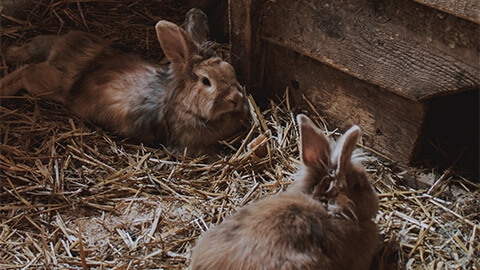
Rabbits are popular pets in Australia (although they are not permitted to be kept as domestic pets in Queensland).
Housing
Rabbits can be housed either indoors or outdoors. Access to unfiltered sunlight and the opportunity to exercise daily is essential to their mental and physical health and wellbeing and must be taken into consideration if housing indoors. Outdoor rabbit enclosures are known as hutches and are either permanent structures or may serve only as temporary housing, to allow the rabbits to graze on grass and get some exposure to natural light. Indoor enclosures are known as pens or cages.
Factors to consider when setting up an outdoor hutch.
- The minimum size should allow the rabbit to stand upright on its back feet and take at least three successive hops, larger hutches are recommended.
- Construction materials should be chew-proof.
- Flooring should be made of wire or large netting. This allows the rabbits to graze and forage on grass. Be mindful that wire can lead to a condition known as pododermatitis.
- Bedding must also be used on the flooring in certain sections, hay, sawdust, straw, or chaff are usually used.
Factors to consider when setting up an indoor pen or cage.
- Plastic or stainless steel cages with stainless steel floors can be used, although larger pens are recommended to allow more space per animal.
- Bedding must be used on the stainless steel flooring, hay, sawdust, straw, or chaff are usually used.
- If free-roaming is allowed in a room or the entire house then protection from predators, dogs, cats, and small children, must be maintained.
Watering Systems
- Watering bottles can be made of glass or plastic, often plastic is preferred over glass due to its durability. Bottles must be made from a material that can be washed in detergents without breaking down. Stainless steel sipper tubes with a ball-bearing valve are inserted into the water bottle via a bung. Bungs may be made of cork or rubber and have a protective steel disk covering to prevent animals from gnawing them.
- Ceramic or earthenware bowls may also be used as watering systems for rabbits. However, bowls must be raised off ground level to ensure that rabbits can not contaminate water by pushing bedding, food, and faeces into the bowl.
- Automatic watering systems are commonly used where there are a large number of rabbits housed together, such as in an animal house setting. Administering medications and water via automatic watering systems can save a lot of labour in these situations. However, there are several disadvantages with this method, rabbits may play with the watering system and leakage is quite common causing potential enclosure flooding. Regular maintenance of automatic watering systems is essential to control the build-up of bacteria and fungi.
Temperature and Ventilation
- If the rabbits will be housed entirely indoors (either temporarily or permanently), it is important to maintain a temperature of around 16– 20 degrees Celsius. A constant relative humidity of around 50% is ideal conditions for a rabbit as low relative humidity can cause respiratory problems. Access to fresh air is extremely important when housing rabbits, the bacterial breakdown of urea in faeces produces ammonia which can irritate the mucous membranes of animals and lead to respiratory infections. Adequate air exchanges will reduce the number of pathogens and odours and help maintain the desired temperature and humidity.
Exercise and Socialisation
- Rabbits are social creatures, so having more than one is encouraged. You can successfully mix rabbit species and also house rabbits with cats and dogs providing there is no inter-species aggression. However, housing guinea pigs with rabbits is generally discouraged as guinea pigs can contract fatal diseases (such as Bordetella Bronchiseptica) from rabbits.
Guinea Pigs are small pocket pets that weigh between one and two kilograms, they are docile and make good family pets.
Housing
Guinea Pigs can be housed outdoors, in hutches, or indoors. Important: Guinea pigs should not be housed with rabbits due to the possible transmission of potentially fatal Bordetella Bronchiseptica from rabbits to guinea pigs. Indoor enclosures are known as pens or cages. Mobile racks of metal cages and plastic cages are suitable for housing smaller numbers of animals and floor pens are generally used to hold larger numbers of animals.
Factors to consider when setting up an outdoor hutch.
- The minimum size for a guinea pig hutch, housing one guinea pig is 1m x 0.5m x 0.25m high.
- The flooring of hutches should be made of wire or large netting. This allows for grazing and foraging on the grass. Be mindful that wire can lead to a condition known as pododermatitis.
- Bedding should allow the animal the ability to burrow so straw or hay is recommended (straw and hay can also be eaten and is an excellent source of fibre). If wood shavings and sawdust are used for bedding, it is important that there are no cyanides in the wood as this could be deadly to guinea pigs and damp wood shavings and sawdust can promote fungal infections.
Factors to consider when setting up an indoor pen or cage.
- Indoor floor pens should be at least 40cm high to ensure there are no escapees.
- Due to the large volume of guinea pigs that may be contained in a floor pen, it is essential that ease of cleaning is considered during construction.
Watering Systems
Watering bottles can be made of glass or plastic, often plastic is preferred over glass due to its durability. Bottles must be made from a material that can be washed in detergents without breaking down. Stainless steel sipper tubes with a ball-bearing valve are inserted into the water bottle via a bung. Bungs may be made of cork or rubber and have a protective steel disk covering to prevent animals from gnawing them. Automatic watering systems are commonly used where there are a large number of guinea pigs housed together, such as in an animal house setting. However, there are several disadvantages to automatic watering systems, guinea pigs may play with the watering system and leakage is quite common causing potential enclosure flooding. Regular maintenance of automatic watering systems is essential to control the build-up of bacteria and fungi. Important: Guinea pigs cannot synthesize Vitamin C so it must be provided in their diet to avoid deficiencies and the development of health issues such as scurvy. Generally, Vitamin C (and other medications if required) is added to their drinking water daily.
Temperature and Ventilation
Outdoor housing should be well ventilated and placed in a draught-free area out of the weather. Guinea pigs are extremely susceptible to heat stress so indoor provisions may have to be made during extreme summer weather. Indoor housing should maintain a temperature of around 18– 23 degrees Celsius. A constant relative humidity of around 50% is ideal for a guinea pig as low relative humidity can cause respiratory problems. Access to fresh air is extremely important when housing guinea pigs, the bacterial breakdown of urea in faeces and urine produces ammonia which can irritate the mucous membranes of animals and lead to respiratory infections. Adequate air exchanges will reduce the number of pathogens and odours and help maintain the desired temperature and humidity.
Exercise and Socialisation
Guinea pigs have quite fragile bones and internal organs, therefore handling must be done carefully and children must be advised to be gentle and always sit on the ground when playing to avoid potentially dropping the animal. Guinea pigs will squeak when they are hungry and will often communicate with their owner in this manner, they also make a purring noise indicating enjoyment while being petted or stroked. Guinea Pigs are social animals and can be housed in groups.
Mice are popular pets, they are highly intelligent, affectionate, and provide hours of entertainment for their owners.
Housing
Typically mice are housed in open-top cages with wire lids, care should be taken when removing mice from their enclosure and when putting them back to ensure their toes and tails are not caught in the lid. Mice are also great escape artists - secure housing is essential for keeping them safe and contained.
Factors to consider when setting up a mouse enclosure.
- Offer enrichment within the enclosure, a wheel, or other 'toys'.
- Provide hides and nesting materials.
- Protect them from predators, have a secure lid, and don't place the enclosure where animals such as cats and dogs can attack it.
Temperature and Ventilation
- Mice prefer warmer temperatures, and if necessary will huddle together and build nests to keep warm. Try to maintain enclosure temperatures between 19– 21 degrees Celsius.
Exercise and Socialisation
- Mice are very active, so an exercise wheel or similar in their cage is advised. Mice live in social groups, these groups must be maintained from the time of weaning to limit inter-group aggression and so that they can establish a hierarchy. Male mice tend to fight (dependant on their breed) this must be monitored and provisions put in place to ensure inter-group aggression does not result in injury to more vulnerable animals.
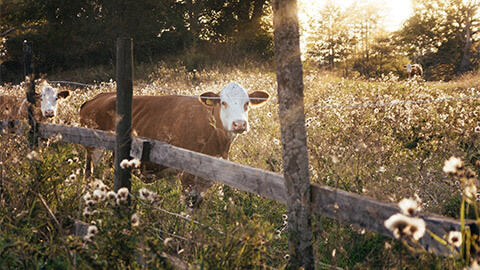
Livestock such as cows, sheep, goats, and pigs are normally kept on farms as production animals.
Housing
Sheep and cows tend to live outside in paddocks all year long, therefore fencing and gates must be well maintained to prevent escape and/or injury. Sufficient protection from the elements must be provided, this usually consists of natural barrier protection (trees or shrubs). Pigs are often housed in a blended inside and outside enclosure or shed, overcrowding should be avoided. Chickens are often housed in sheds or free-range enclosures. Protection from predators must be taken into consideration for all types of livestock, wild dogs and snakes are of particular concern.
Temperature and Ventilation
Livestock requires protection from the elements. Natural shelter (trees/bushes) or man-made shelters should be provided.
Exercise and Socialisation
Livestock do not really need traditional exercise however their paddock must be of sufficient size to allow free-roaming. Livestock generally congregate in groups for safety against prey species. Sheep, in particular, should not be housed alone. Livestock can be wary and will often move away from you as you approach.

Horses, whilst technically a form of livestock, are more often kept as pets for exercise and companionship.
Housing
Horses may live in paddocks all year long, therefore fencing and gates must be well maintained to prevent escape and/or injury. Sufficient protection from the elements must be provided, this may include natural barrier protection (trees or shrubs) or access to a sheltered yard or stable. Any housing must be protected from predators.
Temperature and Ventilation
During winter horses may be rugged to protect them from the cold.
Exercise and Socialisation
Depending on the use of the horse their exercise needs will vary. For example, racehorses are highly athletic animals and are exercised each day. Family-owned horses may only be ridden once or twice a week. Horses must have access to a paddock or yard of sufficient size to allow them to run (canter) around if they want to. Horses are social animals and enjoy living with other horses, they will often engage in social activities such as playing and mutual grooming. If they are housed individually then plenty of human interaction is required as a substitute.

